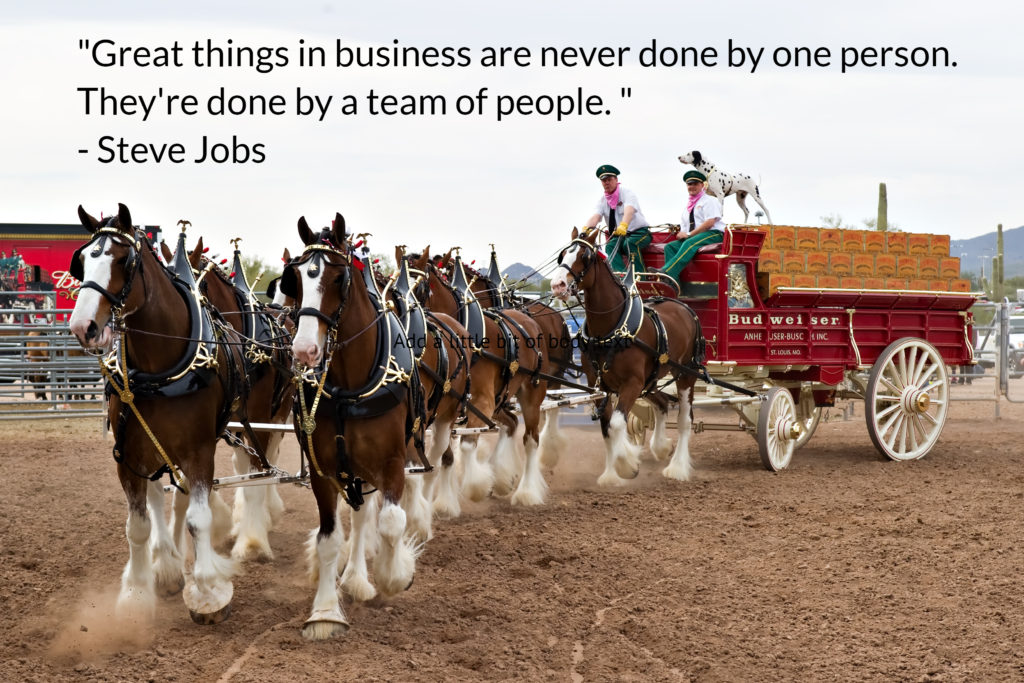
By Ginny Telego
If you have ever had the chance to see the Budweiser Clydesdales in person, you know that it is amazing to watch how this team of 8 horses work together in sync to make what they do look effortless. “Teams” of horses have been productive in cultures all over the world for thousands of years. What is interesting about creating this seemingly effortless teamwork is that it takes time to develop. The managers at Warm Springs Ranch, where the Budweiser Clydesdales are raised, don’t just put the horses out in a pasture together to have fun and expect them to do their jobs when they get hooked up to the wagon at an event. It takes time to find the right horses who have the temperament, strength and ability to learn to be part of the team. And the trainers work with the horses everyday – both in individual interactions as well as practicing hitching them up to each other – so they can allow the horses to learn how to work together. In fact, horses get moved around in the hitch arrangement to ensure they are in the “right” spot for them to be successful.
A Google search of “team building” yields 582,000,000 results. Companies talk about team building incessantly – constantly in search of a way to make their teams work more cohesively and with reduced conflict. It seems that just about any gathering can be turned into “team building.” Whether golf, bowling, building a car out of cardboard, or cooking a meal together, companies spend millions of dollars on activities meant to create more productive teams. One executive bought tickets for his senior management team to attend a fundraiser/social networking event that was at a local brewery and said they used it for team building. Certainly it is important for teams that spend thousands of hours working together over the course of a year to get to know each other on a personal level and hitting golf balls or having a few beers together can be a great way to do that. But if companies really want to create teams that can engage in a way that looks like the Budweiser Clydesdales effortlessly moving together in all directions, they have to invest in something more in-depth.
Redefining the goal to DEVELOP a team is much more results oriented and can move a team from just hanging out together to actually working together to build trust, learn how to manage conflict in a healthy way, create commitment, address accountability, and focus on results. Team development focuses on taking the team through Tuckman’s Stages of Group Development – Forming, Storming, Norming, Performing – so that they can truly work from a place of individual strengths as well as collaboratively.
So how can you determine what is right for your team and whether a program fits your goals?
- Ask what the outcome is that you want from the group spending time together.
- If you want them to just get to know each other better and create camaraderie, then a team building experience such as golf, cooking, white-water rafting or even going out for pizza and beer will fit that goal. Social gatherings are a great way for teams to get to know each other outside of the workplace.
- If you want them to learn to communicate better, reduce conflict and be more innovative, then team development is needed.
- What makes programs offering team development different from team building?
- Team development programs are intensive, experiential programs that not only challenge teams to work better but also have experienced facilitators who can guide conversation after experiential activities in a way that creates awareness of strengths and challenges among team members, uncovers beliefs, thoughts and perceptions that may be hindering the team’s productivity and most importantly, can guide the team in discovering solutions that work for them. Effective team development facilitators have a thorough understanding of the process to move a group from the experience to a meaningful reflection and then onto identifying action steps that can be taken to create a different result.
- Team building programs are more social interaction based. There may be a facilitator involved, but often times that person is primarily on hand to set up an activity for the group and perhaps ask some questions about the experience. In other team building experiences there is no structured activity involved but just activities to create an environment of friendship and camarderie.
Both types of programs are beneficial to organizations and should be utilized. But before your company spends thousands of dollars on a day on the golf course, spend some time thinking about what is going on with the team and whether they need to just “hangout” or if they need to spend a day gaining self-awareness and learning about the strengths and challenges of each other along with identifying real solutions to achieve organizational goals.
Ginny Telego is the President of The Collaboration Partners, a consulting business that provides experiential leadership and team development, coaching and strategic planning retreats to companies and community organizations. She is a Certified Advanced Practitioner-Corporate and Master Trainer with the Equine Experiential Education Association (E3A) and travels in the US and internationally to facilitate leadership and team development as well as train and certify people in equine experiential learning.
